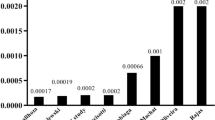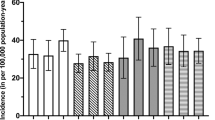Abstract
Purpose
To compare the effect of antiseptics and antibiotics on the occurrence of Infectious Keratitis (IK) secondary to Corneal Foreign Body (CFB) removal.
Methods
Multicenter retrospective study conducted between June 2020 and June 2022 in patients referred for CFBs and treated with Picloxydine (Group 1) or Tobramycin (Group 2) for 7 days. A follow-up visit was scheduled on Day 3 (D3) and a phone call on D30. The primary outcome measure was the occurrence of IK.
Results
307 patients (300 men) with a mean age of 42.8 (14.8) years were included. The mean (SD) time to consultation was 43.1 (45.6) hours. Picloxydine and Tobramycin were given to 155 and 152 patients. Half of patients (n = 154, 50.2%) were building workers and 209 (68.1%) did not wear eye protections. CFBs were mainly metallic (n = 292, 95.1%). Upon referral, rust was found in 220 patients (72.1%). A burr was used in 119 (38.9%) patients. IK occurred in 15 (4.9%) patients, 8 (5.3%) in Group 1 and 7 (4.5%) in Group 2 (p = 0.797). IK was successfully treated in all cases. Persistent rust was found in 113 patients (36.9%) on D3 without difference between burr or needle use (p = 0.278). On D3, corneal healing was delayed in 154 patients (47.2%), mainly in burr-treated patients (p = 0.003). The mean (SD) work stoppage duration was 0.32 (0.98) days.
Conclusion
IK rate was 4.9%. The efficacy of antibiotics and antiseptics was similar on CFB removal. Using a burr was associated with a longer healing time. CFBs had a limited social impact.
This is a preview of subscription content, access via your institution
Access options
Subscribe to this journal
Receive 18 print issues and online access
$259.00 per year
only $14.39 per issue
Buy this article
- Purchase on Springer Link
- Instant access to full article PDF
Prices may be subject to local taxes which are calculated during checkout

Similar content being viewed by others
Data availability
The data that support the findings of this study are not openly available due to reasons of sensitivity human data and are available from the corresponding author upon reasonable request.
References
Hoskin AK, Mackey DA, Keay L, Agrawal R, Watson S. Eye Injuries across history and the evolution of eye protection. Acta Ophthalmol (Copenh). 2019;97:637–43.
Sun F, Zhou Y, Dong L, Qin H. Relationship between the use and type of eye protection and work-related corneal and conjunctival foreign body injuries. Inj Prev. 2021;27:521–6.
Channa R, Zafar SN, Canner JK, Haring RS, Schneider EB, Friedman DS. Epidemiology of eye-related emergency department visits. JAMA Ophthalmol. 2016;134:312–9.
Fong LP, Fong LP. Eye injuries in Victoria. Aust Med J Aust. 1995;162:64–8.
Sigurdsson H, Hanna I, Lockwood AJ, Longstaff S. Removal of rust rings, comparing electric drill and hypodermic needle. Eye Lond Engl. 1987;1:430–2.
Filho ETM, Lago A, Duarte K, Liang SJ, Lima AL, Freitas D. Superficial corneal foreign body: laboratory and epidemiologic aspects. Arq Bras Oftalmol. 2005;68:821–3.
Martiano DH, Galliot F, Plouhinec A, Cochard C, Cochener B. Ectasie cornéenne secondaire sur corps étranger métallique intracornéen. J Fr Ophtalmol. 2017;40:e19–e22.
Brissette A, Mednick Z, Baxter S. Evaluating the need for close follow-up after removal of a noncomplicated corneal foreign body. Cornea. 2014;33:1193–6.
Smadar L, Dotan G, Abumanhal M, Achiron A, Spierer O. Demographic, clinical features, and outcomes of pediatric non-penetrating ocular foreign bodies. Graefes Arch Clin Exp Ophthalmol. 2020;258:1469–74.
Budzinskaya MV. Ocular flora in patients undergoing intravitreal injections: antibiotic resistance patterns and susceptibility to antiseptic picloxydine. Int J Ophthalmol. 2020;13:85–92.
Keating GM, Scott LJ. Moxifloxacin: a review of its use in the management of bacterial infections. Drugs. 2004;64:2347–77.
Stapleton F, Shrestha GS, Vijay AK, Carnt N. Epidemiology, microbiology, and genetics of contact lens–related and non–contact lens-related infectious keratitis. Eye Contact Lens Sci Clin Pr. 2022;48:127–33.
Masson E. Prescrire les antibiotiques par voie locale en ophtalmologie. EM-Consulte. Available at: https://www.em-consulte.com/article/113448/prescrire-les-antibiotiques-par-voie-locale-en-oph [Accessed August 3, 2022].
Anon.European Medicines Agency (EMA). Quinolone- and fluoroquinolone-containing medicinal products. Amsterdam, 2020.
Correia S, Poeta P, Hébraud M, Capelo JL, Igrejas G. Mechanisms of quinolone action and resistance: where do we stand? J Med Microbiol. 2017;66:551–9.
Goldstein MH, Kowalski RP, Gordon YJ. Emerging fluoroquinolone resistance in bacterial keratitis. Ophthalmology. 1999;106:1213–318.
Lautenbach E, Larosa LA, Kasbekar N, Peng HP, Maniglia RJ, Fishman NO. Fluoroquinolone utilization in the emergency departments of academic medical centers: prevalence of, and risk factors for, inappropriate use. Arch Intern Med. 2003;163:601.
Opitz DL, Harthan JS. Review of azithromycin ophthalmic 1% solution (AzaSite®) for the treatment of ocular infections. Ophthalmol Eye Dis. 2012;4:OED.S7791.
Retsema J, Girard A, Schelkly W, Manousos M, Anderson M, Bright G, et al. Spectrum and mode of action of azithromycin (CP-62,993), a new 15-membered-ring macrolide with improved potency against gram-negative organisms. Antimicrob Agents Chemother. 1987;31:1939–47.
Morita Y, Tomida J, Kawamura Y. Responses of Pseudomonas aeruginosa to antimicrobials. Front. Microbiol. 2014;4. Available at: http://journal.frontiersin.org/article/10.3389/fmicb.2013.00422/abstract [Accessed August 6, 2022].
Akpek EK, Vittitow J, Verhoeven RS, Brubaker K, Amar T, Powell KD, et al. Ocular surface distribution and pharmacokinetics of a novel ophthalmic 1% azithromycin formulation. J Ocul Pharmacol Ther. 2009;25:433–40.
Granet D, Lichtenstein SJ, Onofrey B, Katz JA. An assessment of the tolerability of moxifloxacin 0.5% compared to azithromycin 1.0% in DuraSite. Clin Ophthalmol Auckl NZ. 2007;1:519–25.
Khalatyan AS, Kholina EG, Strakhovskaya MG, Budzinskaya MV, Shevlyagina NV, Zhukhovitsky VG. Antibacterial effect of the antiseptic picloxydine dihydrochloride on conjunctival isolates of gram-negative bacteria. Vestn Oftalmol. 2021;137:238.
James JW, Baker JA, Wiggins LF. Synthesis of some heterocyclic derivatives of biguanide with antibacterial activity. J Med Chem. 1968;11:942–5.
Khalatyan A, Budzinskaya M, Kholina E, Strakhovskaya M, Kolyshkina N, Kovalenko I, et al. Sensitivity of antibiotic resistant coagulase-negative staphylococci to antiseptic piсloxydin in eye drops Vitabact. J. Clin. Pract. 2020. Available at: https://journals.eco-vector.com/clinpractice/article/view/17543 [Accessed August 3, 2022].
Pirogov YI, Shustrova TA, Oblovatskaya ES, Khromova ES. The state of conjunctival flora and its susceptibility to “Vitabakt” in cataract patients compared to other antibiotics used in ophthalmologic practice. Ophthalmol J. 2018;11:75–9.
Debbasch C, Chaumeil C, Quesnot S, Batellier L, Scat Y. Amebicide activity of antiseptics and an antibiotic on 2 Acanthamoeba. isolated from corneal ulcers. J Fr Ophtalmol. 1998;21:577–82.
Liston RL, Olson RJ, Mamalis N. A comparison of rust-ring removal methods in a rabbit model: small-gauge hypodermic needle versus electric drill. Ann Ophthalmol. 1991;23:24–7.
Zuckerman BD. Corneal rust ring: etiology and histology. AMA Arch Ophthalmol. 1960;63:254.
Fernald RD. More than meets the eye. Behav Brain Sci. 1987;10:378–9.
Author information
Authors and Affiliations
Contributions
The trial protocol was designed and written by the authors (BR, AM, SN). BR and FT collected all patients data. SN performed statistical analyses. SB, FB, AR, KR brings them clinical experience for the analysis of the results. The manuscript was written by BR, AM, and SN, together with all co-authors, who vouch for the accuracy of the data reported. All authors edited and approved the manuscript.
Corresponding author
Ethics declarations
Competing interests
The authors declare no competing interests.
Additional information
Publisher’s note Springer Nature remains neutral with regard to jurisdictional claims in published maps and institutional affiliations.
Supplementary information
Rights and permissions
Springer Nature or its licensor (e.g. a society or other partner) holds exclusive rights to this article under a publishing agreement with the author(s) or other rightsholder(s); author self-archiving of the accepted manuscript version of this article is solely governed by the terms of such publishing agreement and applicable law.
About this article
Cite this article
Rebattu, B., Baillif, S., Ferrete, T. et al. Corneal foreign bodies: are antiseptics and antibiotics equally effective?. Eye 37, 2664–2672 (2023). https://doi.org/10.1038/s41433-022-02380-0
Received:
Revised:
Accepted:
Published:
Issue Date:
DOI: https://doi.org/10.1038/s41433-022-02380-0



